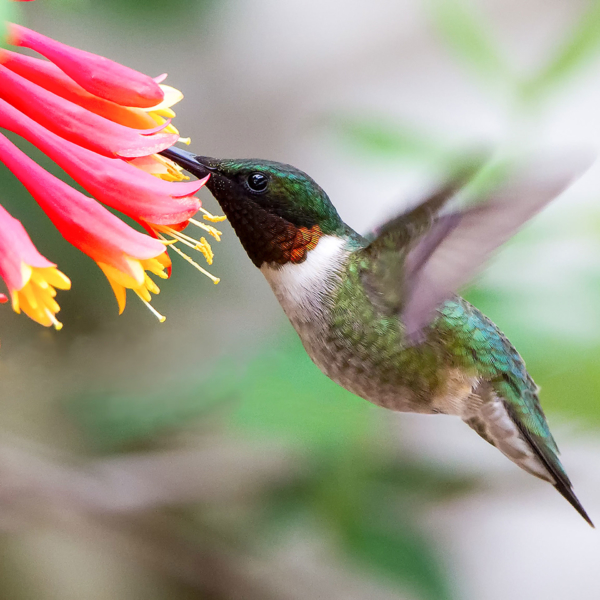
“The daily hummingbird assaults existence with improbability.”
– Ursula K. Le Guin
Not only captivating to look at, hummingbirds have been a favorite of gardeners for centuries for their helpful pollinating abilities. With wings beating anywhere from 50-100 times per second, hummingbirds are amazingly quick. To help you keep these fast, flitting birds around, we recommend that you do everything you can to create a habitat for them, including a garden full of their favorite plants.
As a general rule, hummingbirds prefer flowers that are elongated tube- or trumpet-shaped, and they are most often are attracted to colors like purple, red, and pink. Plant a variety of annual blooms, perennials, and taller trees and flowering shrubs to give them further access to food sources and shelter. We’ve assembled a collection of our favorite hummingbird-friendly perennials below.
Salvia
Gardeners have been longtime lovers of Salvia for its ability to attract hummingbirds to their gardens. Covered in small, delicate blooms, you’ll love these sensationally colorful, shorter, spiking annuals. With so many varieties to choose from, there is sure to be one you’ll love. We recommend Black and Blue Anise Sage (Salvia guaranitica) and Scarlet Sage (Salvia splendens) for the best hummingbird results.
To grow your own salvia, plant them where they will be sure to have full sun exposure. They can handle a bit of watering neglect, but they won’t tolerate being overwatered. Keep them growing happy and healthy with well-draining soil and occasional watering. Take good care of your salvia plants throughout the season and you can enjoy their fragrant blooms and the hummingbirds they draw right until fall.
Digitalis
Commonly known as Foxglove, Digitalis is another powerhouse for attracting hummingbirds. These flowers feature all the little birds’ favorite features: tubular flowers, bright colours, and tall growing habits for easy access, reaching up to 4’ tall. Blooming early in the season, this biennial is the perfect way to welcome hummingbirds into your yard for the spring. You can find foxglove in many gorgeous colors, but red is a hummingbird’s favorite and may be more effective at drawing them in. For a stunning red hue, try our Camelot Rose Foxglove, with deep, rosy blooms.
Your foxglove will do best in full sun to partial shade. Space the individual plants about 14 inches apart for mass planting or using as bedding. Keep the soil evenly moist, but don’t overwater or you may see your plant drown. You’ll love the aesthetic and hummingbirds these flowers bring to your garden, but these flowers aren’t for everyone. Foxglove is known for being toxic to humans and animals, and care should be taken for anyone with children or pets.
Penstemon
Penstemon, also known as Beardtongue, is another beautiful bloomer that hummingbirds love. This spikes of this perennial adorn themselves in little, tubular flowers that hummingbirds love in the mid and late season. Coming in blue, white, and purple, these colorful flowers are gorgeous and low-maintenance, so you’ll have more time to enjoy their beauty and the birds they draw in.
You can plant your penstemon in full sun to partial shade. These plants are drought tolerant and prefer drying out their soil slightly between waterings. When you do water, take care not to overdo it – penstemon has been known to wilt and die if they’re left in standing water. A well-draining soil will also help to keep this from happening. Spend less time watering and more time admiring with these fabulous flowers that will bring in hummingbirds without the extra work.
Monarda
Also known as Beebalm, this perennial is a favorite of not just bees and butterflies, but it is also adored among hummingbirds, too! Their stunning flowers have a spreading and mounding habit that makes them perfect for filling out your garden. The pretty pincushion blooms come in many brilliant and bright shades of pink and red, making them a sure lure for hummingbirds throughout the midseason.
Monarda will thrive in full to partial sun areas of your garden. It is an amazingly adaptive plant that can handle both dry and moist soils. For best results, we recommend regular watering when the soil is dry to the touch. Take care to watch your new plants as they grow – they are self-seeding and may continue to spread if you don’t keep an eye on them. Keep them where you want them and you’ll be sure to see happy, healthy plants with hummingbirds and other flying friends in your garden this year.
More Perennials: Hosta, Columbine, Aquilegia, & Daylily.
Annuals: Flowering Maple, Cleome, Fuschia, Lantana, Petunia, & Flowering Tobacco.
Shrubs: Weigela, Butterfly Bush, Rose of Sharon, & Red Buckeye.
You can also help these little birds by providing freshwater or a fountain for them to sip from, and plenty of larger shrubs and trees where they can hide and perch. If you put out a hummingbird nectar feeder, make sure you clean it well and often, so they don’t get sick. For a little extra fun, you can even add a Hummingbird Swing for them to hang out on!
To learn more about hummingbird habits and their favorite plants, join us at Weston Nurseries and take a look at all the hummingbird-happy plants we have on display. For more info, Check out the full Hummingbird Plant List here!







